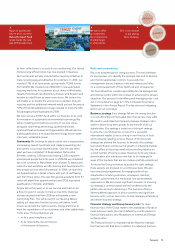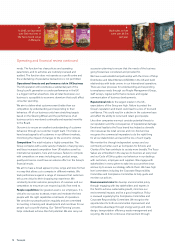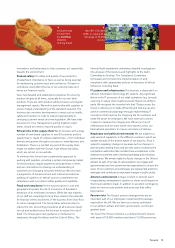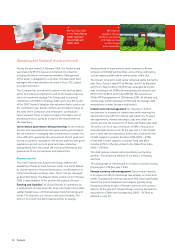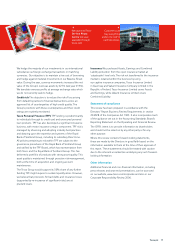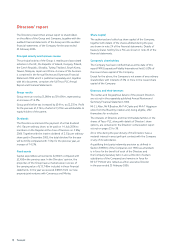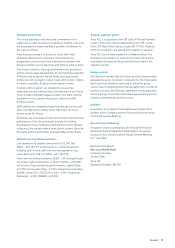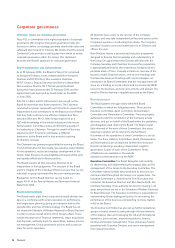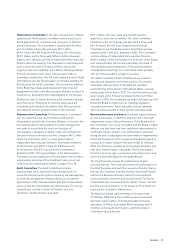Tesco 2006 Annual Report Download - page 25
Download and view the complete annual report
Please find page 25 of the 2006 Tesco annual report below. You can navigate through the pages in the report by either clicking on the pages listed below, or by using the keyword search tool below to find specific information within the annual report.23Tesco plc
This process is cascaded through the Group with every
International CEO and local Board conducting and maintaining
their own risk register and assessing their own control systems.
The same process also applies functionally in those parts of
the Group requiring greater overview. For example, its terms of
reference require the Audit Committee to oversee the Finance
Risk Register. A further example is that of the Corporate
Responsibility Risk Register which specifically considers social,
ethical and environmental (SEE) risks. Oversight of these risks
is the responsibility of the Corporate Responsibility Committee.
The Board incorporates SEE risks on the Key Risk Register
where they are considered material or appropriate.
With reference to the ABI guidelines on social responsibility,
we confirm that the Board takes regular account of the
significance of SEE matters. We recognise that certain
stakeholders take a keen interest in how companies
manage SEE matters and so we report more detail on our
policies and Key Performance Indicators (KPIs) in our
Annual Corporate Responsibility Review and on our website
(www.tesco.com/corporate). To provide further assurance, the
Corporate Responsibility KPIs are audited on a regular basis
by Internal Audit.
Internal controls Accountability for managing risk at an
operational level sits with management. We have a Group-wide
process for establishing clearly the risks and responsibilities
assigned to each level of management and the expected
controls required to be operated and monitored.
The CEOs of subsidiary businesses are required to certify by
way of annual statements of assurance that the Board’s
governance policies have been adopted in practice and in
spirit. For certain joint ventures, the Board places reliance upon
the systems of internal control operating within our partners’
infrastructure and the obligations upon partners’ Boards
relating to the effectiveness of their own systems.
Monitoring The Board oversees the monitoring system and
has set specific responsibilities for itself and Board or Executive
Committees as set out below. The Audit, Finance, Compliance
and Corporate Responsibility Committees’ reports are
distributed to the Board and a formal discussion on each is
held at least once a year. These all provide assurance that the
Group is operating legally, ethically and in accordance with
approved financial and operational policies. We continue
to review how the Turnbull Guidance has been applied. In
addition, internal and external audit play key roles in the
monitoring process.
• Audit Committee Annually, the Audit Committee reports
to the Board on its review of the effectiveness of the
internal control systems for the accounting year and the
period to the date of approval of the financial statements.
Throughout the year the Committee also receives regular
reports from the internal and external auditors and has
dialogue with senior managers on their control
responsibilities.
It should be understood that such systems are designed
to provide reasonable, but not absolute, assurance against
material mis-statement or loss.
•Internal Audit The Internal Audit department is fully
independent of business operations and has a Group-wide
mandate. It operates a risk-based methodology, ensuring
that the Group’s key risks receive appropriate regular
examination. Its responsibilities also include maintaining
the Key Risk Register and facilitating risk management
and internal control with the Board, Audit Committee
and senior management throughout the Group. Internal
Audit facilitates oversight of risk and control systems of
Group companies through a number of risk committees
established on either a geographic or business basis.
The Head of Internal Audit also attends all Audit
Committee meetings.
• External Audit PricewaterhouseCoopers LLP, the
Company’s external auditors, contribute a further
independent perspective on certain aspects of the internal
financial control system arising from their work, and report
to both the Board and the Audit Committee.
The engagement and independence of external auditors
is considered annually by the Audit Committee before they
recommend their selection to the Board. The Committee
has satisfied itself that PricewaterhouseCoopers LLP are
independent and there are adequate controls in place to
safeguard their objectivity. Such measures include the
requirement to rotate audit partners every five years. We
have a non-audit services policy which sets out criteria for
employing external auditors and identifies areas where
it is inappropriate for PricewaterhouseCoopers LLP to work.
Non-audit services work carried out by
PricewaterhouseCoopers LLP is predominantly transaction
work and corporate tax services. PricewaterhouseCoopers
LLP also follow their own ethical guidelines and continually
review their audit team to ensure their independence is not
compromised.
• Finance Committee Membership of the Finance
Committee includes Non-executive Directors with relevant
financial expertise, Executive Directors and members of
senior management. The Committee usually meets twice a
year and its role is to review and agree the Finance plan on
an annual basis, to review reports of the Treasury function
and to review and approve Treasury limits and delegations.
• Compliance Committee Membership of the Compliance
Committee includes two Executive Directors, the Company
Secretary and members of senior management. It normally
meets six times a year and its remit is to ensure that the
Group complies with all necessary laws and regulations in
all of its operations world-wide. The Committee has
established a schedule for the regular review of operational
activities and legal exposure and it formulates and
monitors the implementation of, and compliance with,
appropriate policies.
Every International business in the Group also has a local
Compliance Committee designed to ensure compliance
with their local laws and regulations.


